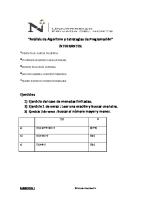Zoric 1
Descripción completa
Views 33 Downloads 0 File size 89KB
Recommend stories
- Author / Uploaded
- azoric218
Citation preview
Zoric 1
Anja Zoric Professor Dunlap HMD 302 Homework Assignment #4 It was not until the last couple of decades that people have become more comfortable with issues of homosexuality. Unfortunately, topics such as homosexual parents still remain controversial. Whereas evidence suggests that there are not too many proven differences between children raised by homosexual parents rather than by heterosexual parents, less obvious differences can be assumed. The fact that many people have mixed opinions about same-sex couples raising children has an impact on how the children of same-sex couples perceive their families and therefore themselves. In some ways this can be a negative thing, but there are also many ways in which it can be positive. One of the main arguments being used in present day to support lesbian parents is that there are close to no reported cases of abuse (particularly sexual abuse) within these households (Gartrell, Bos & Goldberg, 2010). Lesbian mothers often highly desire their children, which is not always the case for heterosexual parents. It is clear that a family with desired children is less likely to experience child related stress factors, which in turns creates less of a chance of abuse. Furthermore, since heterosexual adult males are usually the most likely to sexually abuse an individual, a child being raised by two mothers is not exposed to this risk. Also in support of lesbian parenting, they are less likely to use corporal punishment and are more likely to equally share the responsibilities of child-rearing (Gartrell et al., 2010). I thought it was really interesting that Schoomaker brought up the point that lesbians can be seen as a threat to our male-dominated society because they do not rely on males in the household environment (Davis, Cole & Rothblum, 1993). This can be a very positive influence
Zoric 2
on young female children being raised by two mothers. Whereas young girls in heterosexual families are often exposed to their fathers being the head of the household, they subconsciously begin to internalize their status of inferiority. A young girl being raised by lesbians on the other hand is exposed to a system in which females hold power and make the decisions, encouraging her to internalize positive attributes associated with her gender. This relates perfectly to the social constructions theory because gender is something that is socially constructed. The fact that lesbian mothers resist these socially constructed ideas is a positive influence on their children, especially their daughters. Tasker and Golombok (1995) talk about the possible difficulties that children of homosexual families might face such as bullying in school or embarrassment when having to share family background information with others. Children subconsciously learn that most families consist of a mother and father, so they may internalize negative views about their family if they have two mothers. This might be particularly relevant for adolescent females because the concept of false self is more prevalent among them. On the other hand, homosexual mothers often times realize that their families may face difficulties with discrimination and therefore join support groups. Children being raised in these families have the advantage of support groups other than school. Heterosexual couples are most likely less inclined to seek out support groups for familial problems because they belong to the majority.
Zoric 3
References Davis, D. N., Cole, E., Rothblum, D. E. (1993). Faces of Women and Aging. Binghamton, NY: Harrington Park Press. Gartrell, N., Bos, H., Goldberg, N. (2010). Adolescents of the U.S. National Longitudinal Lesbian Family Study: Sexual Orientation, Sexual Behavior, and Sexual Risk Exposure. Archives of Sexual Behavior. doi:10.1007/s10508-010-9692-210.1007/s. Tasker, F., Golombok, S. (1995). Adults Raised as Children in Lesbian Families. American Journal of Orthopsychiatry, 65(2).









